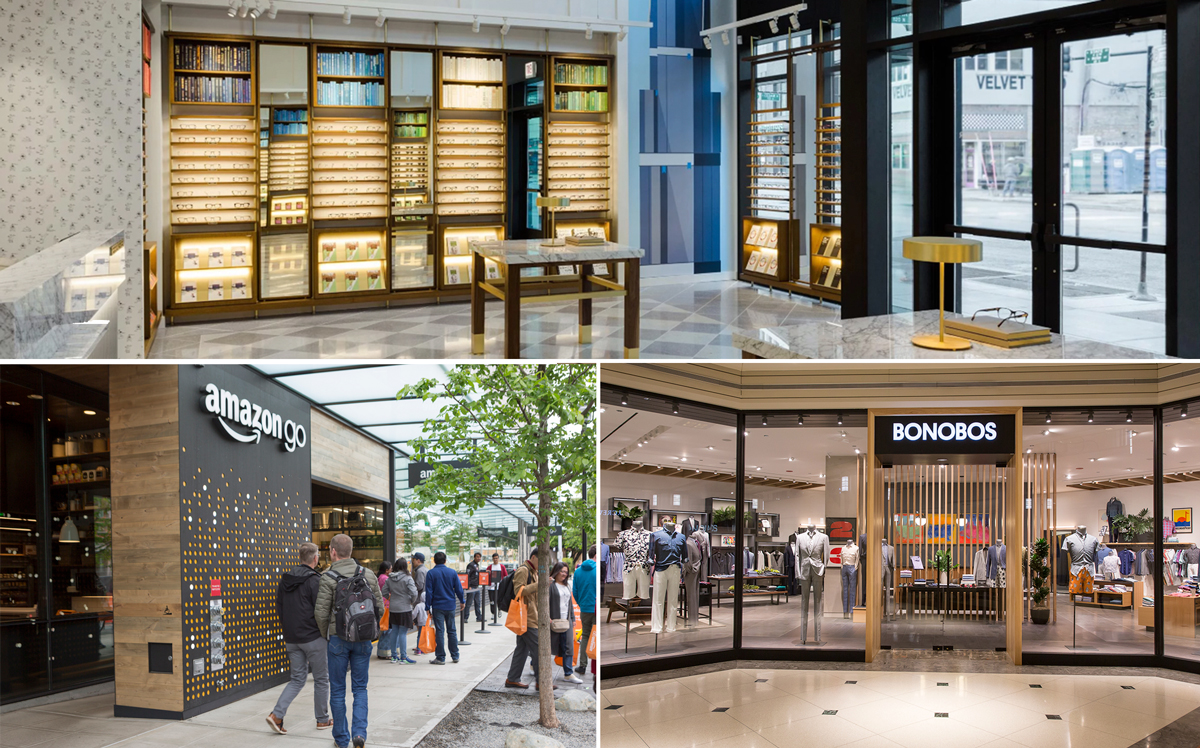Trending
“Clicks-to-bricks” is in Chicago to stay, but where does it go from here?
Landlords are sizing up the potential for online brands like Amazon and Warby Parker to fill up empty storefronts

Early in the third-quarter earnings call for retail landlord Acadia Realty Trust, CEO Ken Bernstein called out a particular string of Chicago leases to buck up investors after a punishing 2017.
“In Lincoln Park, newcomers such as Allbirds and Outdoor Voices are joining Serena & Lilly, Bonobos and Warby Parker in our Armitage Avenue property,” Bernstein said. “These openings are going to help drive our performance in 2018 and 2019.”
Those five brands share at least two characteristics: They sell their products predominantly online, and none operated a store in Chicago before 2015.
Three years after Acadia leased eyewear up-and-comer Warby Parker to its first Chicago showroom at 851 West Armitage Avenue, digital retailers large and small are opening brick-and-mortar locations around the city.
Amazon this month opened its second Chicago “Amazon Go” store with plans to open another two, Google is reportedly eyeing a potential retail space in Fulton Market after opening a pop-up in Bucktown, and luggage startup Away will open an outpost next to Warby Parker’s Gold Coast showroom, according to Crain’s.
Since first surfacing in New York’s SoHo neighborhood around 2011, the so-called “clicks-to-bricks” phenomenon has spread to other major cities. A JLL report this month listed Chicago as the country’s fourth-hottest real estate target for digital retailers, with about 5 percent of companies choosing Chicago for their flagship brick-and-mortar location.
Warby Parker’s executives were “blown away” by the instant success of its physical storefronts, retail spokesman Ruthie Ben-Zvi said. The company, which launched in 2010, plans to surpass 100 worldwide stores next year.
Online clothing retailer Bonobos, another early pioneer of “clicks-to-bricks,” is also teasing plans to expand past its four existing Chicago locations. Bonobos’ growing crop of boutique-sized stores offers customers “full immersion into the brand” and confronts them with products they wouldn’t otherwise consider, said Andrew Neelon, the company’s head of real estate strategy.
“A showroom that enables customers to touch and try on our products really helps fuel them to pull the trigger,” Neelon said. “We’ve found that the customers we acquire in stores purchase more, and purchase more frequently.”
Online retailers’ fluid inventory and robust delivery operations allow their stores to take up a fraction of the space of more traditional apparel brands, Neelon added.
Evidence suggests even small storefronts can help retailers juice their online sales. A recent survey from the International Council of Shopping Centers found that, on average, retail brands see a 37 percent boost in web traffic when they open a store in a new market.
The newcomer brands also benefit by being able to shake up what’s become an all-too-familiar array of corporate retailers, said Peter Caruso, JLL’s senior vice president for Chicago-area retail sales.
“Our retail world has become pretty darn cookie-cutter,” Caruso said. “You see all the same brands out there every three miles, and I think the world in general is looking for something different.”
Caruso estimated some 850 digital retail operators are exploring commercial real estate nationwide, with some 200 on the radar of JLL’s Chicago office.
“Most people have only ever seen 50 or 60 brands at most,” he said.
So far, digital brands have focused a few corners of the Chicago retail universe, clustering in Lincoln Park and Lakeview’s Southport corridor. But expansion to other areas could be inevitable, according to Sean Sharko, a retail investment broker with Marcus & Millichap.
“They’re being very strategic about opening in areas with very high foot traffic and high retail pockets” like Lakeview and the Gold Coast, Sharko said. “But the area around Armitage and Damen [in Bucktown] has become very boutiquey, and as Fulton Market continues to expand, I think it could become a destination too.”
Online brands have only just begun to creep into the suburbs, but Oak Brook Center and Skokie’s Old Orchard Mall could catch the next wave of expansions, Sharko predicted.
Simon Property Group, which has two regional malls and two outlet malls in the Chicago area, has been actively courting online retailers, President and Chief Operating Officer Richard Sokolov said in an earnings call last week.
“We have … probably 25 retailers that started on the internet that have opened stores with us and are opening more,” Sokolov said. “Because … they work and they make money.”
Added CEO David Simon, “The store experience and the store requirement is back, and that shouldn’t be under-appreciated. They all want stores.”
Landlords don’t expect fresh-out-the-gate online startups to save them from the “retail apocalypse.” Caruso noted online retailers’ newcomer status in the real estate industry has made banks wary of funding large-scale expansions, and property owners are hedging on the companies with short-term leases.
And so far in Chicago, digital operators have “not really moved the overall economics” of retail leasing, Sharko said. But they’ve already shown an important, if symbolic, impact.
“I think it’s injected confidence in a space that had been waning,” Sharko said. “It’s showing the investment community that brick and mortar does have a place.”




